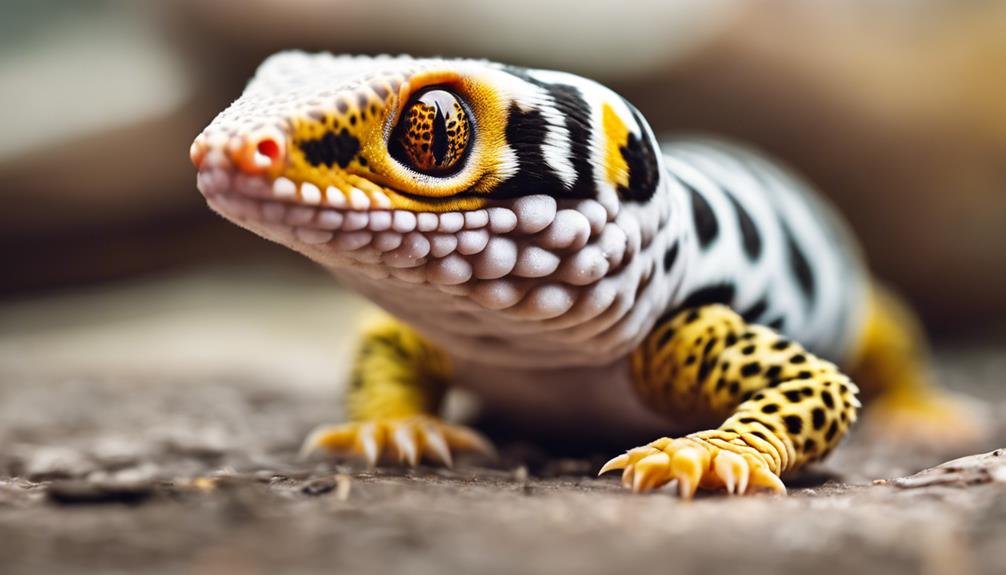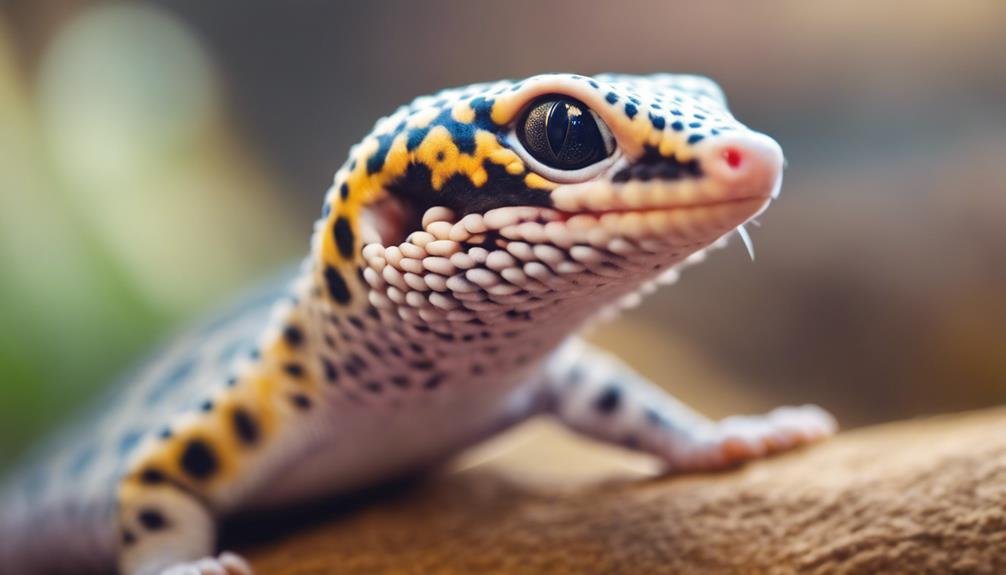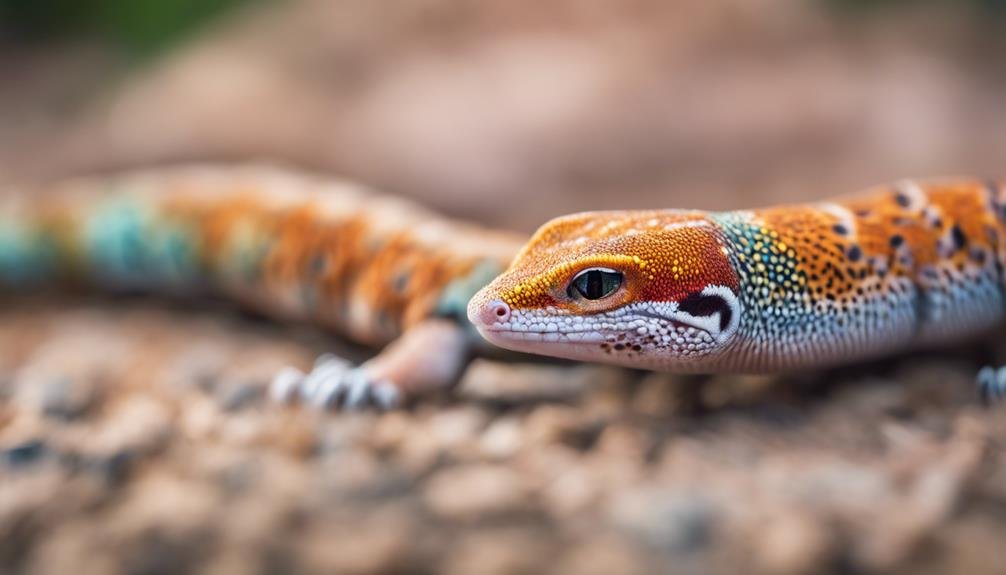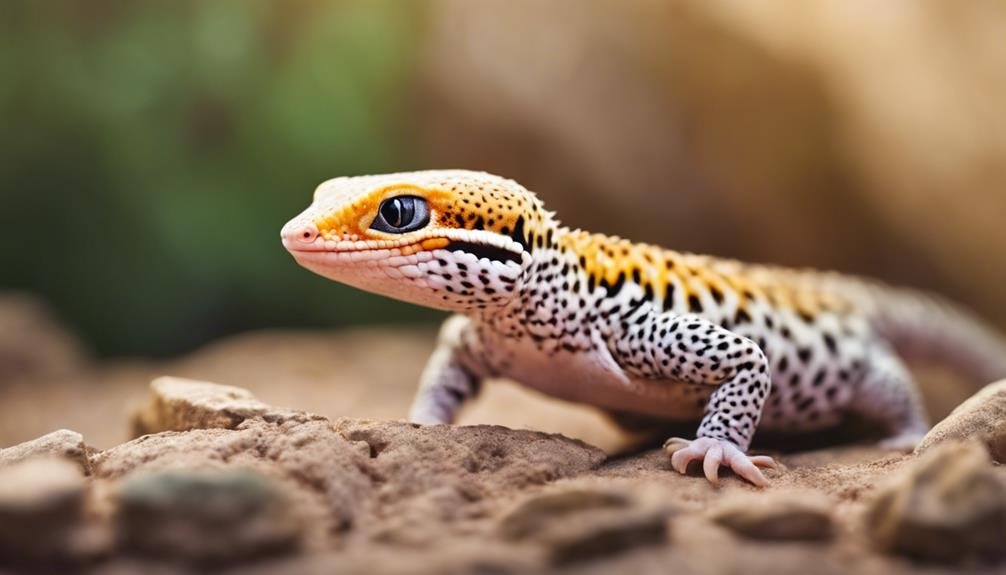When you’re examining your leopard gecko’s tail, you’re not just looking at a part of its body; you’re peering into a window of its health. A healthy tail should be plump and rounded, a sign of good fat reserve and overall well-being. But if you notice any thinning, discoloration, or textural changes, it’s a red flag that shouldn’t be ignored. These signs can point to undernourishment or even more serious health issues. Understanding what a healthy tail looks like and the subtle signs of trouble is essential for any leopard gecko owner. So, let’s explore what keeps that tail in tip-top shape and how to spot the warnings that something might be amiss.
Key Takeaways
- A healthy leopard gecko tail should be plump and well-rounded, indicating good fat reserves.
- The tail should have consistent thickness, reflecting proper nutrition and health.
- Look for a smooth, vibrant color and texture without any signs of undernourishment or injury.
- There should be no signs of retained shed on the tail, ensuring good circulation and skin health.
- A healthy tail should not be bony or thin, as these are signs of undernourishment.
Characteristics of a Healthy Tail
A healthy leopard gecko’s tail should be plump and well-rounded, serving as an essential storage for fat reserves. This feature isn’t just a sign of a well-fed pet; it’s a critical health indicator.
When you notice your gecko’s tail starting to slim down, it’s a red flag that shouldn’t be ignored. Weight loss in these reptiles, especially if it’s rapid or severe, can be a telltale sign of undernutrition or other health issues.
Signs of Undernourishment
If you notice your leopard gecko’s tail getting thinner or showing changes in color and texture, it’s time to take a closer look at its diet and health.
A tail that lacks its usual plumpness can signal that your gecko isn’t getting the nutrition it needs.
Keep an eye on these signs to guarantee your pet maintains a healthy and nourished state.
Tail Thickness Variation
Observing the thickness of your leopard gecko’s tail can reveal important insights into its nutritional health. A plump tail signifies a healthy lizard, boasting adequate fat reserves essential for their wellbeing.
Conversely, if you notice your adult gecko’s tail appearing bony or noticeably thinner, it’s a red flag for undernourishment or potential health issues, including bone disease. This condition demands immediate attention, as the tail’s fat reserves are vital for their overall health, acting as a buffer during lean times.
Baby geckos naturally have smaller, flatter tails than their adult counterparts, but a noticeable thinness in an adult’s tail could indicate a serious need for a nutritional reassessment to prevent further health complications.
Color and Texture Changes
Noticing changes in the color and texture of your leopard gecko’s tail can be a clear indicator of undernourishment. A healthy tail should be plump, signifying adequate fat stores for energy and health maintenance. However, if you observe any of the following, it might be time to reassess your pet’s diet and health:
- A bony or thin tail texture in adult geckos, different from the smoother, fuller tails seen in healthy individuals.
- Baby geckos with unusually flat tails, which might suggest they’re not absorbing or receiving enough nutrients.
- Visible signs of undernourishment, such as a lack of the characteristic plump appearance.
- Undigested food in their habitat, indicating potential health issues impacting their ability to properly store fat in their tails.
Understanding Shedding Issues


If you’ve noticed your leopard gecko’s tail shedding in patches or not at all, it’s important to act quickly. Ensuring the right humidity levels and providing a moist hide are key to preventing shedding issues.
We’ll explore how to spot problems, create the ideal conditions for shedding, and offer solutions to common challenges.
Identifying Shedding Problems
Identifying shedding problems in leopard geckos is vital, as retained shed can lead to serious health issues, including restricted circulation in toes and the tail. It’s important to recognize the signs early on to make sure your pet remains healthy and comfortable.
Here’s what you should look out for:
- Stuck Shed on Toes: This is a common area where retained skin can restrict blood flow.
- Tail Tip Retention: The tail tip is sensitive and can be affected by improper shedding.
- Shed Remnants on Body: Any part of the body with stuck shed needs attention.
- Check Regularly: Make it a habit to inspect your gecko, especially after a shed, to catch any issues early.
Promptly addressing these shedding problems is key to maintaining your leopard gecko’s well-being.
Proper Shedding Conditions
Why is it that proper shedding conditions are essential for your leopard gecko’s health, particularly in preventing tail issues? Good care includes creating an environment that supports effective shedding. Adequate humidity levels and a moist hide are vital.
Without these, your gecko might struggle with retained shed on its tail, leading to serious complications like circulation problems or even tail loss. To prevent these distressing outcomes, you’ll need to regularly inspect their tail during shedding periods.
Ensuring it sheds completely is a key part of providing a suitable shedding environment. This attention to detail in their care contributes greatly to maintaining a healthy leopard gecko tail. Remember, good care is proactive care, especially when it comes to shedding.
Common Shedding Solutions
Understanding how to address shedding issues effectively is key to maintaining your leopard gecko’s health, especially when it comes to their tail. Monitoring the shedding frequency (sheding频率) can help you spot any abnormalities early.
Here’s what you should do:
- Ensure proper humidity levels to facilitate a smooth shedding process. This is vital for their overall skin health.
- Provide a moist hide in their enclosure to aid in effective shedding.
- Gently remove any stuck shed from their toes or tail, as this could lead to circulation problems.
- Maintain adequate hydration and a balanced diet to support healthy shedding.
Addressing Tail Loss


When your leopard gecko loses its tail, it’s important to immediately create a calm environment to support its recovery. Tail loss is a defense mechanism, often triggered by stress or improper handling. The key to aiding your gecko through this period is minimizing stressors and ensuring that its habitat is peaceful and secure.
A lost tail will regrow, but it won’t be the same as before. The new tail may be shorter, stubbier, and lack the original coloration or pattern. It’s essential to understand and accept these changes as part of your gecko’s recovery process.
| Aspect of Recovery | Importance |
|---|---|
| Stress-Free Environment | Reduces the risk of further tail loss and aids in quicker recovery. |
| Limited Handling | Prevents additional stress and potential harm to the regrowing tail. |
| Observation | Allows for early detection of any issues in the regrowth process. |
| Acceptance | Helps you adjust expectations regarding the appearance of the regrown tail. |
Monitoring for Tail Rot
Keep an eye out for any signs of blackening or necrotic tissue at your leopard gecko’s tail tip, as this could indicate the onset of tail rot. Tail rot, a serious condition, can stem from various factors including injuries, poor husbandry, or bacterial infections. Recognizing the signs early is vital for your pet’s health.
Here’s what you need to watch for:
- Blackened or Necrotic Tissue: The most obvious sign of tail rot is a noticeable change in the color and texture of the tail tip, turning black and appearing decayed.
- Soft or Mushy Tail: Feel the tail gently; a tail beginning to rot may feel softer or mushier compared to the healthy parts.
- Lethargy or Changes in Behavior: Your gecko might become less active or show signs of distress if it’s experiencing discomfort from tail rot.
- Loss of Appetite: A gecko suffering from tail rot might eat less or refuse food altogether due to pain or discomfort.
Early detection of tail rot is key to prevent further tissue damage. If left untreated, it can lead to severe infections, possibly requiring amputation to save your leopard gecko’s life.
Preventing Common Tail Problems


To avoid common tail problems in your leopard gecko, maintaining a healthy environment and proper diet is vital. A healthy leopard gecko’s tail should look plump and rounded, showcasing good fat stores. This indicates your pet is getting the right amount of nutrients without being overfed. Overfeeding can lead to obesity, resulting in a fatty tail and other health complications. It’s important to keep an eye on the tail for any signs of injury, infection, or issues with shedding.
Ensure your leopard gecko’s habitat is spacious enough and equipped with adequate hides. This setup helps prevent tail injuries by offering a safe retreat and reducing stress. Proper handling is also key to avoiding tail dropping, a defense mechanism geckos use when they feel threatened. Gentle, confident handling can minimize this risk.
To sum it up, the well-being of your leopard gecko’s tail is a direct reflection of their overall health. By monitoring their diet, providing a safe environment, and handling them correctly, you can prevent most common tail problems. Remember, a healthy tail is a happy tail in the world of leopard geckos.
How Can I Tell If My Leopard Gecko’s Tail is Healthy?
When it comes to losing a leopard gecko’s tail, it is important to know what a healthy tail looks like. A healthy tail is plump and full, without any signs of thinning. Look out for any unusual bumps, lumps, or discoloration, as these can be indicators of underlying health issues.
Frequently Asked Questions
What Does a Healthy Leopard Geckos Tail Look Like?
When you’re checking if your leopard gecko’s tail is healthy, you’ll want to see a plump, well-rounded shape. This shows they’ve got enough fat stored up. Don’t worry if it’s not massive; babies naturally have smaller tails.
But if it’s bony or thin, especially in adults, that’s a red flag. They could be underfed or sick. Also, watch out for tail shedding—it’s normal but can indicate stress or health issues.
What Does an Infected Leopard Gecko Tail Look Like?
If your leopard gecko’s tail looks swollen, discolored, or has any foul odor or discharge, it’s likely infected. You may notice signs of necrosis, where the tissue appears damaged or dead, indicating a serious condition known as Tail Rot.
This infection can spread quickly, endangering your pet’s health. It’s vital to seek veterinary care immediately to treat the infection and prevent further complications. Don’t wait, as prompt action is essential.
What Does an Unhealthy Leopard Gecko Look Like?
If you’re checking for signs of an unhealthy leopard gecko, look beyond just the tail. Notice if they’re less active or show changes in eating habits.
A sick gecko might also have a thin, bony tail, signaling undernourishment or dehydration.
Watch for any lethargy or unusual behavior, as these can be clear behavioral signs of illness. Early detection is key to addressing any health issues they might face.
Should My Leopard Geckos Tail Be Fat?
Yes, your leopard gecko’s tail should be fat. It’s a sign they’re healthy and getting enough to eat. Their tail stores fat for times when food’s scarce.
If it’s skinny, you might need to look at their diet. Baby geckos’ tails start small but will plump up as they grow.
Proper diet management is key to ensuring they have a fat tail, reflecting their good health. Keep an eye on it!
Conclusion
In sum, keeping your leopard gecko’s tail plump and well-rounded is key to ensuring their well-being. Watch out for signs of undernourishment, understand shedding issues, and know how to address tail loss and prevent rot.
By keeping an eye on your gecko’s tail and taking prompt action if problems arise, you’ll help prevent common issues and maintain their health. Remember, a healthy tail is a clear sign of a happy, healthy gecko.


